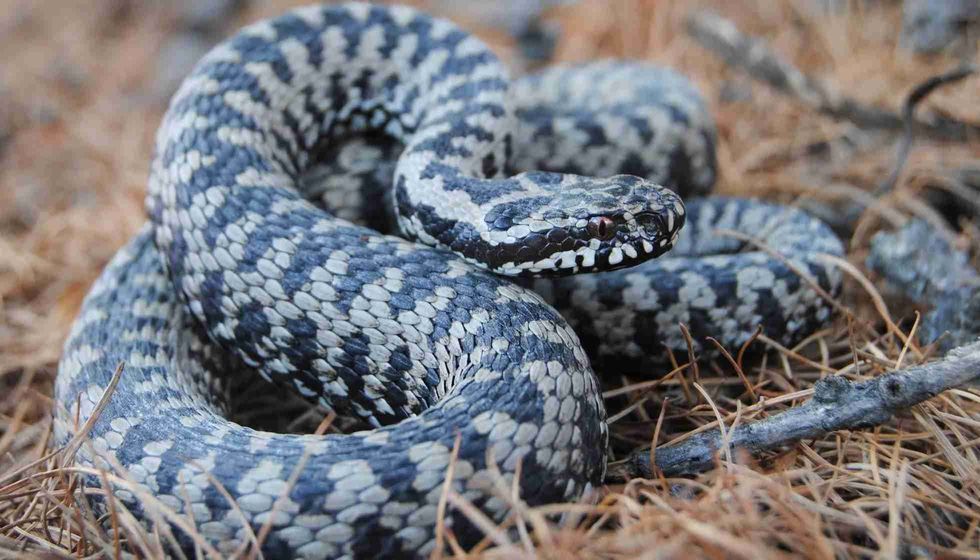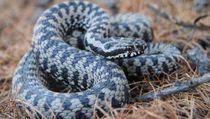The adder (Vipera berus) is a venomous snake in the family of vipers. Both young and adult adders can be identified by their zig-zag patterns, spots on the skin, and red eyes.
Generally, male adders are silvery-gray in color and females are reddish dark brown. They are carnivores who feed on rats, mice, frogs, lizards, newts, and other small mammals.
There are different varieties of adders such as the common adder, death adder, puff adder, and mountain adder. Their size varies by region but an adder typically grows up to 24-35 in (61-89 cm). The common habitats of adders are grassland, moorland, woodland, and heathland.
Adder snakes can be found across the Eurasian landmass. This species is generally non-aggressive and tends to bite only when alarmed.
Adder snakes are the only known venomous species of snakes in Great Britain and they use their venom to immobilize their prey. In the United Kingdom, adders can be found from the south coast to Scotland, however these snakes are not in Ireland.
You'll find in this article more adder snake facts and information about the black adder native place, viper skin pattern, the common name for an adder (Vipera berus), and what small mammals young male adders feed on.
You can also check out our fact files on the puff adder and common death adder from Kidadl.
Adder Interesting Facts
What type of animal is an adder?
An adder is species of snake that belongs to the family of vipers also known as Vipera berus. They are mostly found in the Arctic circle and across Eurasia.
What class of animal does an adder belong to?
An adder belongs to the class of reptiles known as Reptilia which means they are a variety of snakes.
How many adders are there in the world?
There are many species of adders in the world. A few of them are endangered but many are not. There is no record of the total number of adder snakes in the world.
Where does an adder live?
Adders live in woods, wetlands, and deserts. They prefer places with good hiding spots or places where they can camouflage.
What is an adder's habitat?
The common habitats of adders are woodlands, moorlands, heathlands, and grasslands. They are shy snakes and prefer places where they can hide which also makes it easier for them to prey.
Who do adders live with?
Adders generally live on their own and mind their own business unless it’s their mating season. During reproduction, the male adder follows the scent of the female. After mating, they stay together for up to two days.
During reproduction, male adders sometimes pick a fight with another male when challenged. This fight lasts until one of them is beaten or tired. Other than this period, adders tend to be alone.
How long does an adder live?
On average, adders can live in their natural habitat for between 10-15 years.
How do they reproduce?
Female adders commonly reproduce once every two years. This might extend to once every three years if the climatic conditions are not favorable or if the seasons are short.
Some subspecies of adders are known to reproduce once a year as well. The male tracks the scent of females.
If there is a competition between males for mating, both males will try to chase each other away or enter into combat resulting in the ‘adder dance’. The male that manages to push the other one down or the last one standing wins the combat and gets to mate.
The winning male and female mate and stay together for a couple of days. Young adders are hatched within the female and are generally 5.5-9.1 in (14-23.1 cm) in length including their tail.
What is their conservation status?
The conservation status of adders is Vulnerable. In the United Kingdom, adders are protected under the Wildlife and Countryside Act, 1981. They are also protected under Priority Species under the UK post-2010 biodiversity framework.
Adder Fun Facts
What do adders look like?
The body of adder snakes is usually thick. Adults grow up to 24-35 in (61-89 cm) in length which can vary by region. They have a fairly large head and the sides are flat.
From above, the rostral scale is barely visible with two small scales behind them. Their eyes are red, relatively large in males and smaller in females. There are often 21 rows of strongly keeled dorsal scales on their midbody.
They have different color patterns, often dark brown being the dominant one. The most common pattern is the zig-zag patterns that cover the entire length of their body. They also have a distinct V or X-shaped mark on their head.
How cute are they?
Its cuteness depends on how you look at it. Some might find the red eyes, split tongue, dark-colored scales, and the V shape on its head to be cute, while some other might find it a bit frightening. It’s totally up to you to decide.
How do they communicate?
Like other snakes, adders also communicate using scents, vibration, and sensitive structures. They understand chemical cues present in their surroundings using their sense of smell and taste.
Adders also use a chemical known as pheromones to communicate. They leave and collect pheromones in their surroundings which helps them understand the gender and condition of reproduction of other young and adult adders around them.
How big is an adder?
A full-grown adder snake will be about eight to 10 times bigger than an average frog in your backyard. An adder is roughly about 3.2 ft (1 m) in length.
How fast can an adder move?
The average speed of movement is about 2 mph (3.2 kph), which is slower than your average walking speed. Although they might move faster when alarmed or triggered.
How much does an adder weigh?
An average adult European adder weighs about 0.11-0.39 lb (0.05-0.17 kg). They are rarely found over 0.62 lb (0.28 kg).
What are the male and female names of the species?
There are no separate names for the male and female species of adders, although their appearance is varied. Females are more reddish-brown and males are generally found in silvery gray.
What would you call a baby adder?
Neonates or hatchlings are common names for young adders, which is also the same name for the offspring of other snake species.
What do they eat?
Adder snakes eat small mammals, rats, mice, ground birds, newts, lizards, and frogs.
Are they poisonous?
Yes, adders are poisonous snakes.
Would they make a good pet?
As it falls under the range of venomous snakes, a European adder won’t make a good pet. Also considering their shy nature, they are best left in the wild.
Did you know...
The name ‘adder’ is a historical mispronunciation of the Old English word ‘nadder’, meaning 'serpent'.
Adder eggs hatch within the female body.
Adders can deliver venom deep into the tissues of their victims.
What are the different types of adder?
There are about 18 subspecies of adders that fall under viper adder. However, the only species with the common name, adder, is the Vipera berus.
They are native to different places across the world, mostly in Eurasia.
The subspecies include the desert death adder, death adder, long-nosed adder, horned adder, mud adder, many horned adder, mountain adder, nightingale adder, Namaqua dwarf, common adder, puff adder, Peringuey’s adder, African puff adder, sand adder, Rhombic night adder, dwarf sand adder, water adder, and Namib dwarf sand adder.
Though adders fall under the category of venomous snakes, not all adders are dangerous to humans.
Is an adder's bite and venom dangerous?
Adder snakes use their venom to immobilize small mammals. They spend most of their days swallowing their prey or drying themselves in the sun.
Adders have one of the most detailed venom delivery mechanisms. They have the potential to deliver venom deep into their prey’s tissues, making them extremely effective. Though their venom has enough poison to kill a human, there are only a few cases of deaths reported due to adder bites.
This is a similar story when it comes to dogs. It is very rare that an adder snake bite kills a dog. This could be because of their shy nature.
Adders tend to hide from humans and other domestic animals. Almost all cases of adder bites on humans are reported when they were held or cornered.
Here at Kidadl, we have carefully created lots of interesting family-friendly animal facts for everyone to discover! For more relatable content, check out these Burmese python facts and king cobra facts for kids.
You can even occupy yourself at home by coloring in one of our free printable Adder coloring pages.










